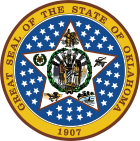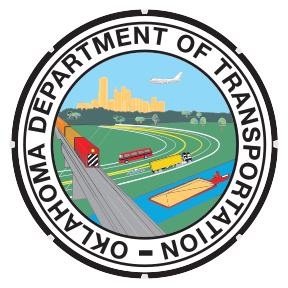 |
|---|
| This article is part of a series on the politics and government of Oklahoma |
Constitution |
Executive
|
Divisions |
Federal Relations
|
The Budget of the State of Oklahoma is the Governor's proposal to the Oklahoma Legislature which recommends funding levels to operate the state government for the next fiscal year, beginning July 1. Legislative decisions are governed by rules and legislation regarding the state budget process.

The Governor of Oklahoma is the head of state for the U.S. state of Oklahoma. Under the Oklahoma Constitution, the governor is also the head of government, serving as the chief executive of the Oklahoma executive branch, of the government of Oklahoma. The governor is the ex officio Commander-in-Chief of the Oklahoma National Guard when not called into federal use. Despite being an executive branch official, the governor also holds legislative and judicial powers. The governor's responsibilities include making yearly "State of the State" addresses to the Oklahoma Legislature, submitting the annual state budget, ensuring that state laws are enforced, and that the peace is preserved. The governor's term is four years in length.

The Legislature of the State of Oklahoma is the state legislative branch of the U.S. state of Oklahoma. The Oklahoma House of Representatives and Oklahoma Senate are the two houses that make up the bicameral state legislature. There are 101 state representatives, each serving a two-year term, and 48 state senators, who serve four-year terms that are staggered so only half of the Oklahoma Senate districts are eligible in each election year. Legislators are elected directly by the people from single member districts of equal population. The Oklahoma Legislature meets annually in the Oklahoma State Capitol in Oklahoma City.

The government of the U.S. State of Oklahoma, established by the Oklahoma Constitution, is a republican democracy modeled after the federal government of the United States. The state government has three branches: the executive, legislative, and judicial. Through a system of separation of powers or "checks and balances," each of these branches has some authority to act on its own, some authority to regulate the other two branches, and has some of its own authority, in turn, regulated by the other branches.
Contents
- Budget Process
- Gubernatorial control
- Legislative control
- Funding sources
- Major revenue categories
- Major expenditure categories
- Constitutional Reserve Fund
- See also
- References
- External links
After the Legislature approves an appropriations bill, it is sent to the Governor, who may sign it into law, or may veto it. A vetoed bill is sent back to the Legislature, which can pass it into law with a two-thirds majority in each chamber. The Legislature may also combine all or some appropriations bills into an omnibus appropriations bill. In addition, the Governor may request and the Legislature may pass supplemental appropriations bills or emergency supplemental appropriations bills.
Several government agencies provide budget data and analysis. These include the Oklahoma Office of State Finance, Oklahoma Tax Commission, the Office of the Oklahoma State Treasurer, and the Office of the Oklahoma State Auditor and Inspector.
The Oklahoma Tax Commission (OTC) is the Oklahoma state government agency that collects taxes and enforces the taxation and revenue laws of the state. The Commission is composed of three members appointed by the Governor of Oklahoma and confirmed by the Oklahoma Senate. The Commissioners are charged with oversight of the agency but appoint an Executive Director to serve as the chief administrative officer of the Commission and to oversee the general practices of the Commission.

The State Treasurer of Oklahoma is the chief custodian of Oklahoma’s cash deposits, monies from bond sales, and other securities and collateral and directs the investments of those assets. The treasurer provides for the safe and efficient operation of state government through effective banking, investment, and cash management. The state treasurer has the powers of a typical chief financial officer for a corporation.

The Oklahoma State Auditor and Inspector is an elected Constitutional officer for the U.S. State of Oklahoma. The State Auditor and Inspector is responsible for auditing and prescribing bookkeeping standards of all government agencies and county treasurers within Oklahoma. The office in its current form is a consolidation of the office of State Auditor with that of the office of State Examiner and Inspector, both of which dated back to statehood in 1907. The two positions were combined in 1979 after passage of State Question 510 in 1975. Tom Daxon was the first person to hold the combined office and the first Republican as all previous occupants of either position were Democrats.




